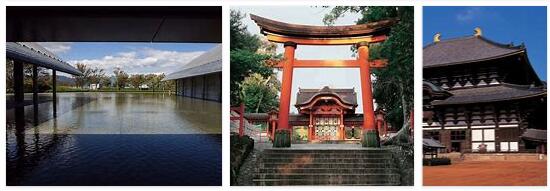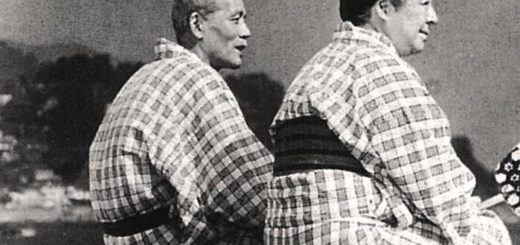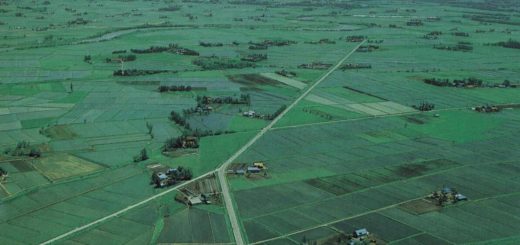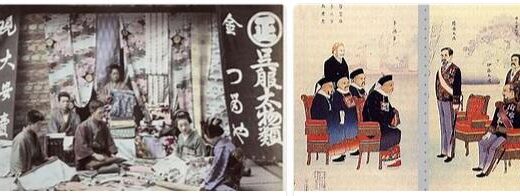Japan Arts and Architecture Part III
Muromachi period
The Muromachi period (1338-1573), or Ashikaga from the name of the dominant clan, including the fifty-year period Nanbokuchō (1336-1392), sees the most complete expression of the aesthetic components linked to Zen in the visual arts, gardens and objects related to the ceremony of tea (chanoyu). Lesser capacity for renewal is found in religious sculpture, but on the contrary splendid masks are made for the nō theater for which sumptuous silk costumes are also made; furthermore, the applied arts, from ceramics to lacquer to bronze, excel in quality and decorative finesse. In ink painting (sumi-e or suibokuga), which reinterprets Chinese models, meets the masterpieces of monk-painters of Zen, or masters extraneous to this religious practice but influenced by its techniques and expressive methods. In the 15th and 16th centuries. some figures of great importance impose themselves; in the second half of the 15th century. the Tosa School and the Kanō School are formed . In Kyoto, the architecture has two famous works linked to Zen: the Golden Pavilion (Kinkakuji, rebuilt after an arson in 1950 but designed in 1397), and the Silver Pavilion (Ginkakuji) of the late 15th century. The most illustrious example in the art of gardens, for symbolic and expressive results, is the ‘dry garden, or dry’ (karesansui) of the Riōanji temple in Kyoto (1473 ca.).
Momoyama period
In the Momoyama period (1573-1615) new trends in architecture took shape with the creation of imposing castles, often destined for a short life, following the fate of their founders. Real feudal fortresses perform the function of defense and ostentation of power; singular is the differentiation between the sumptuous internal aspect and the solid and sober one of the external, which often conceals the real internal dispositions. Among the few remaining examples stands the Himeji Castle, from 1609, defined as the ‘white heron’. Rich are also the decorative solutions of the paints for sliding doors (fusuma) and screens (byōbu) performed by the great masters of the Kanō School who manage, in a profusion of gold and bright colors, to interpenetrate the linearity of sumi-ec with the tradition of yamato-e. Ceramic production, increasingly linked to chanoyu, achieves results of extraordinary expressive and figurative modernity, as evidenced by the Raku, Shino, Karatsu and Oribe pieces, while complex techniques and elaborate ornamentations characterize the lacquers (particularly valuable those of Kōetsu) and fabrics. The contact with the Europeans, who arrived since 1543, will finally lead to the creation of a particular form of art, called nanban (of the “barbarians of the South”), where foreign figurative aspects are assumed, or eminently European techniques are used, in the realization of screens, in the form and decoration of objects, in the shape of some armor.
Edo period
According to NEXTICLE, the Tokugawa era, from the name of the dominant house, is more often referred to as the Edo period (1603-1867), from the name of ancient Tokyo which became the most stimulating artistic pole of the archipelago. Despite the political and cultural isolation from the rest of the world, we are witnessing a great flowering in all fields of art, such as fabrics and clothes, lacquers, wood carvings, ivory and bone, such as the renowned netsuke (small object to hold on the belt other items) and okimono (figurines). Precious blades, armor and accessories are made, while, after the introduction from Korea at the beginning of the 1600s of the techniques for the production of porcelain, the factories that also produce for the export market in Europe multiply; the Nabeshima and Kutani masterpieces are flanked by the pieces Kakiemon, Imari, Satsuma etc., which document between the 17th and 18th centuries. an inexhaustible compositional fantasy, while Ninsei and Kenzan stand out in the production of ceramics.
Two important architectural complexes are built around the middle of the 17th century: the imperial Villa of Katsura, of which we note the purity of lines, formal rigor and refined simplicity; the tombs of the Tokugawa shōguns in Nikko, with elaborate ornamentation. Two wood artists, Enkū and Mokujiki Myōman bring sculpture back to a high level. In painting the production of the Kanō continues at the shogunal court, albeit with a certain drying up of the creative vein, compensated by the growing diffusion of genre painting; schools such as Rinpa, which is linked to ancient traditions, Nanga, of Chinese inspiration, the Zenga, typical of Zen painters, brings together a crowd of masters of the highest level. Finally, world fame is recognized in the prints and paintings of Ukiyo-e («painting of the floating world»).
Meiji period
In the Meiji period (1868-1912), after centuries of shogunal government, the emperor resumed the dominion of the nation, marking the state and cultural system in the sign of a profound modernization that looks to the West. Already between 1700 and 1800 some painters had looked to Western realism, but it is in this phase that painting in the style and with Western Yōga materials was born and matured. After 1876, thanks to the official call of Italian artists, among whom A. Fontanesiemerges (in Tokyo in 1876-78), the painting has an imprint dictated by the Fontanesian lesson; subsequently, through the stay in France of some artists, there is a profound influence linked to French pictorial tendencies. In the same years V. Ragusa is a teacher at the Tokyo School of Fine Arts. Among the pioneers stand out Naganuma Moriyoshi, who studied in Venice, and Ogiwada Morie, who trained in Paris. In architecture, many foreigners (Americans and Europeans) make important works largely lost; Furthermore, between 1875 and 1898, the engraver E. Chiossone worked in Tokyo. At the same time, however, a critical and cognitive reflection on the value of national production begins to emerge; the American EF Fenollosa and Okakura Tenshin re-evaluate the artistic heritage, techniques and expressive forms typical of tradition and enhance the value and originality of Japanese-style painting (Nihonga).



